E-Verify Program Data Collections
E-Verify Program Data Collections
ATTACHMENT F _to OMB Clearance - Arizona Stakeholders Meeting
E-Verify Program Data Collections
OMB: 1615-0115
ATTACHMENT F:
ARIZONA STAKEHOLDERS MEETING SUMMARY, 2009
Contents
Page
I Introduction 1
II Workshop Organization 2
Opening Plenary 2
Closing Plenary 3
III Summary of Priority Issues Across Topics 4
IV Workgroup Summaries by Topic 8
Topic 1: Communication About the E-Verify Program in Arizona 9
Topic 2: Results of and Reactions to a Mandatory E‑Verify Program 11
Topic 3: Identity Fraud in the Workplace 14
Topic 4: Impact of the Legal Arizona Workers Act (LAWA) on Legal Workers 16
Topic 5: Impact of the Legal Arizona Workers Act (LAWA) on Small Employers 19
Topic 6: Impact of the Legal Arizona Workers Act (LAWA) on Multistate Employers 21
Topic 7: Impact of State E-Verify Legislation on Federal Agencies 24
Appendix
A Workshop Information Package A-1
B Westat PowerPoint Slides B-1
STAKEHOLDERS MEETING REPORT
I. Introduction
On March 9, 2009, the U.S. Citizenship and Immigration Services (USCIS) Office of Policy and Strategy and Westat hosted a stakeholders meeting in Phoenix, Arizona. The purpose of the 1-day meeting was to provide an open forum to identify, discuss, and prioritize topics that should be studied in the portion of Westat’s evaluation of the USCIS E-Verify program that will focus on Arizona, where the state has mandated its use.1 The meeting was attended by 55 stakeholders, including Arizona employers, corporate employers with offices in Arizona, small and large employers, community-based organizations, and federal, state, and local government. Thus, participants had experienced the E-Verify program from a variety of perspectives.
The Westat evaluators will use the information from the meeting in the development of protocols for case studies that will be conducted in Arizona in 2009. In addition to identifying issues to be examined, participants indicated which issues they considered to be most important. Identifying stakeholders’ higher priority issues provides important input into the development of key questions for the case studies. Of course, some key issues involve the relationship of E-Verify to other programs or societal patterns and go beyond what can be examined in the current evaluation.
This report consists of three sections and two appendices. The first section explains how the meeting was organized. The second section provides a summary of what participants thought were the highest priority issues for the evaluation to address across the spectrum of the different meeting topics. The third section summarizes the discussions of each of the seven workgroups, emphasizing research questions raised or implied in the discussion. Appendix A includes the advance package of workshop information sent to potential attendees, and appendix B contains the Westat PowerPoint slides presented in the opening plenary session.
Please note that
there has been no attempt to edit stakeholders’ comments for
accuracy about the
E-Verify program but to summarize their
experiences, perspectives, and opinions.
II. Workshop Organization
The workshop consisted of an opening plenary session, seven morning workgroup sessions, six afternoon workgroup sessions, and a closing plenary session. Each workgroup focused on one of seven topics, which were:
Topic 1: Communication about E-Verify in Arizona
Topic 2: Results of and Reactions to Mandatory E-Verify
Topic 3: Identity Fraud in the Workplace
Topic 4: Impact of the Legal Arizona Workers Act (LAWA) on Legal Workers
Topic 5: Impact of LAWA on Small Employers
Topic 6: Impact of LAWA on Multistate Employers
Topic 7: Impact of LAWA on Federal Agencies
Only one session of Topic 5 was offered due to the limited number of small businesses that were able to attend. Topic 7 was provided for federal staff to give them a chance to share information across agencies. Participants were assigned to a morning and an afternoon session using the preferences they had indicated on their registration forms as well as practical considerations such as the number of participants interested in the topic and a desire to spread organizational representation across sessions.
Opening Plenary
Denise Glover,
Westat Project Director, E-Verify Evaluation 2009-2010, gave a
general overview of what would be done in the meeting. She
introduced Sara Speckhard, USCIS Project Manager,
E-Verify
Evaluation and John Ramirez, USCIS Field Office Director from Phoenix
District 25 both of whom welcomed the participants.
Next, Dr. Glover gave a presentation on the evaluation background (see Appendix B). She provided an overview of the legislative history of the program that eventually became E-Verify and the history of evaluations of the program, which began in 1998. She described some major programmatic impacts that have occurred as a result of past evaluations. She mentioned the key research questions for the evaluation: Was the program implemented properly? Were program goals reached? Dr. Glover then described the research methods being used in the current evaluation. She indicated that as the program grows and changes, the need for evaluation continues and she welcomed the help of meeting participants in identifying key issues for examination in Arizona.
Amy Lawson, Associate Chief, Verification Division, USCIS, provided an update on E-Verify. She began with an overview of E-Verify program usage statistics. Ms. Lawson then talked about the verification and accuracy rates and mentioned that 96.1 percent of verification queries are automatically verified as “Employment Authorized,” a substantial improvement from the past. She displayed a map showing the current status of state legislation involving E-Verify. Ms. Lawson talked about recent enhancements to the system and highlighted the program goals for the next two years.
Finally, Joan Michie, Westat Qualitative Task Leader, E-Verify Evaluation 2009-2010, presented the goals of the meeting which were to learn about the specific issues and challenges of implementing and using E-Verify in Arizona, where it is mandatory, and to determine which of these are most important. She then described the process that was used to identify the workgroup topics and gave an overview of the meeting logistics and guidelines for participation in the workgroups.
Closing Plenary
To give everyone an overview of all the topic workshops, one participant from each of the topic sessions presented a summary of the main discussion points for that session. This information was incorporated into the discussion from the individual workgroups in this report.
Amy Lawson provided some closing remarks including some E-Verify program announcements and changes. First, she mentioned that as a result of feedback from the field, a plain language initiative has been begun by USCIS. The E-Verify program will be changing some of the current terms to simpler language. For example, “Tentative Nonconfirmation” will become “Employee Action Needed.” These changes are currently planned to go into effect in 18-24 months. Second, she emphasized that E-Verify is structurally ready to go mandatory nationwide. The system is ready to handle any legislated expansion now. Third, she announced that a group at USCIS will be looking into the issues surrounding Designated Agents (DAs) in the next few months. Additionally, there will be an E-Verify customer service representative specifically trained in DA issues.
Finally, Denise Glover thanked everyone for their participation. She gave special thanks to Rudy Bustamante and Amy Lawson and the Verification Division for their cooperation and assistance in identifying stakeholders.
III. Summary of Priority Issues Across Topics
Although the workgroups discussed separate topics and concerns, there was a great deal of overlap in issues raised. The fact that some of the same issues were raised in many workgroups is a useful indicator of their priority. The following broad research questions reflect what appear to be the highest priority issues.
Do employers and workers understand that employers should not verify members of their existing workforce under E-Verify? At the time that Legal Arizona Worker’s Act (LAWA) was first being implemented in Arizona, there was considerable confusion about whether existing employees needed to be verified. Several factors contributed to the confusion. One was that the potential future requirement that all employees of federal contractors would need to be verified was incorrectly confused with the requirements of LAWA.2 Second, some articles in the media and distributed by various associations contained inaccurate information. Third, the Phoenix area has a very active sheriff who makes visits to local business looking for illegal immigrants. Businesses face severe penalties if illegal immigrants are found. They would rather check all their employees through E-Verify than encounter problems with the sheriff, particularly since the consequences of verifying all workers are considered to be minimal.
Do employers understand Tentative Nonconfirmations (TNCs) and how to handle them? Employers agreed that additional training was needed to explain that a TNC does not mean that the employee is not work-authorized. They reported that some employers do not want to take the extra step to address TNCs. Many workers are fired because the employers do not understand what TNCs are. The TNC may have been received because information in government databases was not updated or it was incorrectly entered during the query process. A very large employer indicated that new hires have reported confusion about TNCs; they do not understand why they received them and what to do about them. One participant shared a case in which an employee’s TNC took months to resolve and was consequently unsure what to do in this situation.
Is more information or guidance needed about particular E-Verify requirements? Several aspects of E-Verify were frequently mentioned as areas needing clarification. They include:
Adhering to the 3-day rule. Participants agreed that the 3-day rule is not very clear. They asked if the 3 days begin from the date of the job offer or when the person starts work. They wondered how hire date should be interpreted. Several participants also mentioned the challenges of adhering to the 3-day rule. For example, a large employer who hires seasonally often hires a large number of temporary workers at one time. This employer said it is difficult to conduct all the verifications in time. The 3-day rule can present problems when an employer has workers in remote locations that may not have fax machines available. Additionally, large multi-state employers who conduct all verifications centrally find it difficult to meet the 3-day rule. Finally, illness and vacations of Human Resources staff can also make it challenging to conduct all verifications within 3 days.
Verifying rehires. Many participants thought that rehires need to go through the E-Verify process again but some were unsure about who is considered a rehire. One employer asked, “What about the difference between people who get re-hired and those who work sporadic hours – how do we handle these people?” Another employer with many seasonal workers commented that their company re-employs, not rehires. Their employees are not terminated from the payroll system when they leave. Another suggested that a specified period of time such as 14 days could be used. A person who is rehired within the gap period would not need to be reverified. One large employer uses this approach and said that employees are not considered terminated until after they have been gone for over 3 weeks. Another large company does similarly but extends the timeframe to 30 days.
Entering foreign surnames into the system. Employers are not sure how to enter multiple surnames and will often submit several combinations until one works. For example, a Spanish surname might have two parts and someone using E-Verify might not know if both parts should be entered as a last name or just the last part. They are also unsure about what to do with hyphenated names. Additionally, some Hispanics do not understand what the Form I-9 is asking and use their maiden name as a middle or last name. Also, different spellings may have been used on different documents. As a result, employers sometimes reenter names through a trial and error process before inputting it correctly and then, it still might receive a TNC. Southeast Asian names present similar and sometimes more complicated problems.
Using designated agents as a possible solution for those who are not comfortable using E-Verify themselves. Other than the one designated agent (DA) in the session for small business, participants in that session were not familiar with the term “designated agent” or aware that this was an option. It was suggested that the E-Verify site inform employers about which DAs are in their area as a resource.
Has mandatory E-Verify had an effect on the labor market? Many participants said that people have left Arizona due to mandatory E-Verify. According to an attorney, initially, many returned to their home country, but now they are either moving to another state or working for cash. Many have moved to neighboring states or states in which they have family connections. If the home country is far away, they cannot go home because of the expense. Many people came to the United States by selling everything, with no plan to return to their home countries. One very large employer said that their entry-level positions are most affected by E-Verify since they must offer higher wages in order to attract these workers. It also reduces the number of entry-level workers who are available in the pipeline for mid-level positions. As a result, according to the employer, it is more expensive to do business in the state, although the poor economy has lessened the effect. About the time that mandatory E-Verify was going into effect, some existing employees left because they thought they would be verified. Some also leave because relatives did not get verified. Some high school students looking for their first job discover they are not legal; they were brought here when they were very young and frequently have American born siblings. Typically these individuals are moving to other states.
At the same time, the economy has had a sharp decline throughout the United States during 2008, when mandatory E-Verify was implemented in Arizona. For the most part, employers thought there was a sufficient labor pool at the present time. However, they expect this to change when the economy recovers. According to a multistate employer in the construction industry, it is difficult to find Americans with the appropriate skills, especially since many vocational classes have been eliminated from high school. Some business are moving across the border rather than bringing workers to the United States.
Several participants mentioned that immigration issues were the main source of the problems, not E-Verify. Participants commented that it is difficult for unskilled workers, except farm laborers, to come to the United States legally.
What is the impact of E-Verify on the economy? Participants reported that school populations have declined resulting in the closure of some elementary schools and the elimination of some programs. Landlords have also been affected by people leaving. In addition, some families have difficulty paying the rent because one member was not verified or moved elsewhere. As the result of the poor economy, some undocumented [and documented?] workers who have been working for a long time were laid off or the business they worked for closed.
Has E-Verify resulted in discrimination? Some participants indicated that employers are more reluctant to hire people they perceive as non-U.S. born. It was reported that some employers are even asking job applicants if they are citizens and not hiring noncitizens. When mandatory E-Verify first went into effect, one company reportedly fired all its non-White employees.
An attorney commented, “There is an impetus for people to not follow through with resolving a TNC. It’s not actionable if an employer does not follow the rules when a new hire gets a TNC, especially if all TNCs are treated the same. The worst penalty would be that the employer has to stop using E-Verify. It costs an employer to train new hires that receive a TNC and give them time off to go to the Social Security Administration (SSA). E-Verify is user friendly to employers, but unless you can show race discrimination there’s no penalty to employers who fire new hires who get TNCs.”
Some participants commented that the Photo Tool was potentially discriminatory because it is only used for documents presented by noncitizens (i.e., the employment authorization card and the permanent resident card).
Do you think mandatory E-Verify is reducing unauthorized employment? Is it protecting workers’ rights? Many participants thought that E-Verify has reduced unauthorized employment but was not protecting workers’ rights. On the other hand, a multistate employer suggested that E-Verify is driving unauthorized employment elsewhere, either underground or to a different state.
Should prescreening be permitted? Participants understood that employers are not complying with E-Verify rules if they prescreen job applicants. However, several participants thought that prescreening should be allowed, and one commented that other forms of prescreening are done such as drug screening. These participants identified employer costs associated with hiring employees, providing them with training, etc., only to find out they are unauthorized to work. In contrast, a few participants thought that prescreening could lead to discrimination.
How serious is identity fraud in Arizona? Participants thought that identity fraud was a very serious problem in Arizona and more severe than in other states. A local government representative said they had hundreds of pending identify fraud cases that involve many of the unauthorized workers now employed in Arizona. They indicated that identity fraud has evolved from creating false identities into stealing and buying IDs and sometimes worker exploitation. For example, this person reported on cases in which U.S. citizens with valid IDs complete the paperwork, but illegal workers show up for the jobs and give part of their salaries to the U. S. citizen. Adults are using the documents of their children who were born in the United States. People are using legal IDs of others who resemble them in appearance and age. U.S. citizens are also using fraudulent documents to avoid paying child support or to cover up something in their backgrounds.
What should be done to make E-Verify procedures clearer to legal workers and to employers? It was suggested that the TNC materials should explain the process in simple steps, use plain, nontechnical language, and that the tone should be less intimidating. The worker should be told what documents they need to resolve the case. Also, it should be made clear that receiving a TNC does not mean that the person is a criminal. Publication of frequently asked questions (FAQs) was suggested as a way to address common questions. Also, information received from DHS help line needs to be more consistent.
What sources of information about E-Verify would be helpful? Several small employers mentioned that they only conduct verifications periodically. Thus, changes may have occurred in the E-Verify program since they last made a query. They suggested that updates on rules and changes in the rules be emailed to all those signed up for the E-Verify program, so they will not miss changes that might be posted only on a banner. Several participants mentioned that they have to log in daily to check on the status of a person receiving a TNC. Employers would prefer to receive an email message when a change in status has occurred. It was also mentioned that simplifying the language in the tutorial would be helpful.
IV. WORKGROUP SUMMARIES BY TOPIC
The goal of each session was to frame and prioritize the research questions related to the topic that participants thought should be addressed in the upcoming evaluation. Topics and subtopics were provided to guide the discussion of each group and participants were encouraged to suggest additional topics. Each of the following summaries incorporates the comments and priorities from all workgroups on that topic and the feedback from workshop reports in the meeting wrap-up session. It is important to note that although the charge to each group was the same, there were differences in the way the groups chose to implement it. Because of these differences, the write-ups of the workgroups are not strictly comparable. In particular, the differentiation between higher priority questions and those of lower priority was not necessarily consistent among groups. Additionally, not all questions discussed in each session could be arranged easily under the subtopics. Also, participants comments made during many of the sessions provided important background information about the topic. Most summaries are organized into three sections:
1. Higher priority questions
2. Lower priority questions
3. Related participant comments
These summaries are not intended to capture the verbatim conversations of the participants. To maximize the usefulness of the summaries for guiding the evaluation, the workgroup summaries emphasize the research questions that participants considered important for the evaluation to address.
Topic 1: Communication About the E-Verify Program in Arizona
In the focus groups conducted prior to the stakeholders meeting, participants spoke about the attention that E-Verify received in the media at the time the program was about to go into effect. They indicated that some information proved to be inaccurate and misleading, and some communication mechanisms were more reliable than others. This session focused on obtaining more information about the type and quality of the various forms of communication about the program in Arizona.
1. Higher Priority Questions
Participants identified the following higher priority issues/research questions they thought the evaluation should address:
What is the impact of communication about the mandatory program on employers and employees? Are news media such as newspapers, TV stations, and radio stations good sources of information about the implementation of a program such as E-Verify? Are other employers, including colleagues and other businesses who have used E-Verify effective resources, particularly for small businesses? Are associations and organizations such as Society for Human Resource Management effective resources? Did the state provide employers with sufficient information about the state mandate? Should and how can workers and community-based organizations be given an opportunity to voice their concerns and learn more about the E-Verify program prior to its implementation? Was the information provided by the local chambers of commerce helpful? Have employers used resources such as immigration lawyers, consultants, accounts and payroll personnel, and the county attorney’s office to learn more about the program? Which sources of information did employees use? What sources of information were considered the most reliable? Had employers heard positive or negative comments from employers who had used E-Verify? Was information in the media positive, negative, or neutral? Was information provided by interest groups positive, negative, or neutral? How did actual use of E-Verify compare to what was said about E-Verify prior to implementation?
Did the use of E-Verify reduce the risk of hiring immigrants who are not work- authorized? Are jobs requiring at least a bachelor’s degree less likely to have applicants that are not work-authorized than jobs with little or no skill requirements?
Was any inaccurate information provided in the media? Did any information sources say that previously hired employees would be verified? Did employers and employees think that current employees who were not verified would lose their jobs on the day the law went into effect? Did employers think they would face severe penalties for non-compliance? What other inaccurate information was provided?
Did employees think there was a connection between E-Verify and the actions of local law enforcement?
What are the most important parts of E-Verify that need clarification? Do employers find it difficult to locate the E-Verify login page? Do employers know where to find the signs indicating that the company uses E-Verify? Would a FAQ page for naturalized citizens be helpful?
Were employers initially worried that there would be many inaccuracies in the data and that much of their time would be spent fixing them? Did inaccuracies in the data turn out to be big problems once they began using E-Verify? Were there many problems with employees who were work-authorized who lost their jobs because E‑Verify reported they were not work-authorized?
How would employers prefer to hear about changes made to the E-Verify program?
2. Lower Priority Questions
Participants considered the following issues to be of lower priority than the preceding:
Is more information needed about particular procedures within the E-Verify program? Is it clear when the 3-day verification rule begins? Is it clear how to handle the verification of rehires? Is sufficient information available about Photo Tool? Is it clear how to enter multiple surnames into the system? What can be done to improve the way the system accepts the order of names? Do small employers need more information about using designated agents as a possible solution for those who are not comfortable using E‑Verify themselves? How do decentralized virtual offices where hiring occurs at many remote locations by numerous hiring managers handle the registration process? What is the hiring or work site for companies that employ consultants or other types of employees who work from home? Would examples or models of employers with different workplace arrangements be helpful?
Has it been easy or difficult to reach E-Verify customer service? Were the E‑Verify technical support people helpful?
Did employers have sufficient time to implement E-Verify before the start date for LAWA?
Did employers explain the new requirement to existing employees? Did employers need to reassure current employees that they would not be verified or lose their jobs? Did existing employees leave the state either because they were not work-authorized or because other family members were not authorized?
How did LAWA being a ballot initiative affect the information provided about it?
How did legal challenges to LAWA affect people’s perception of the law?
Were advertisements by designated agents misleading?
Were employers worried about having to pass the E-Verify master test?
Topic 2: Results of and Reactions to a Mandatory E-Verify Program
Arizona was the first state to mandate that E-Verify be used by all employers in the state. The implementation and impact of the E-Verify program in a mandatory environment is the focus of the on-site component of the evaluation for 2009-2010. This session focused on the issues that employers and employees have encountered.
1. Higher Priority Questions
Participants identified the following higher priority issues they thought the evaluation should address:
Has E-Verify resulted in discrimination? Are employers more reluctant to hire people they think are noncitizens? Are employers asking job applicants if they are citizens and then only hiring citizens? Is the Photo Tool potentially discriminatory because it is only used for noncitizens? Are companies hiring only citizens for more sensitive jobs such as working in oil refineries? Are companies firing their non-White employees? Are employers verifying existing employees rather than just new hires? If so, are they doing this deliberately or because they don’t understand the program requirements?
What is the impact of E-Verify on the economy? Are businesses moving across the border rather than bringing workers to the United States? Are school enrollments declining due to E-Verify? Have school programs been cut due to declining enrollments as immigrant families leave the state? How have landlords been affected by people leaving the area? Are families having difficulty paying rent because one member was found not work authorized or moved elsewhere? Are there linkages between the high home foreclosure rate in Phoenix and the implementation of mandatory E-Verify? Are there sufficient numbers of legal workers available now? What happens to the supply of legal workers once the economy rebounds?
What is the impact of E-Verify on families? Have families had to separate when one parent was not found work authorized or was concerned that he or she will not be found work authorized? Are families making plans and saving money in case they must return to their home country?
How are TNCs being addressed? Are employers accompanying employees to SSA to clear up TNCs? Are employers firing employees before they have a chance to fix the TNC problem? Are employees quitting rather than fixing the TNC problem? Is the cost of renewing a work permit a reason that employees do not try fixing their paperwork? Are employees with TNCs moving from job to job and staying in each one just until they are told about a TNC? Are employees with TNCs looking for employers who do not use E-Verify? What are the costs (i.e., time and expense) of resolving TNCs that occurred because of government data entry errors?
Are employees without work authorization looking for employment with companies they have heard are not using E-Verify?
Do you think mandatory E-Verify is reducing unauthorized employment? Is it protecting workers’ rights?
Is an appeals process available for people who receive a final nonconfirmation, when it is a government error that was not corrected through the TNC process?
2. Lower Priority Questions
Participants considered the following issues to be of lower priority than the preceding:
How are employers responding to the new law? Does E-Verify provide some protection for employers in industries which have a higher probability of being visited by the U.S. Immigration and Customs Enforcement (ICE)? Has the requirement to use E-Verify put businesses that were using the program prior to the mandate on equal footing with other similar companies? Is use of E-Verify by staffing agencies considered a benefit that will help attract clients?
Has there been an increase in the use of borrowed or stolen IDs since E-Verify was mandated? Are job applicants using the photo IDs of people who look like them? Have there been increases in the same ID being used by multiple people?
What is the impact of the reduction of available jobs due to the poor economy on workers? Where are undocumented long-term employees, who lost jobs recently because the company has closed or scaled back, looking for jobs? Are legal immigrant workers without documentation reluctant to apply for jobs because of concerns about E-Verify? Are fewer workers available because illegal immigrants are not applying for jobs? Are existing employees less likely to change jobs, even for more pay, as a result of E-Verify?
Are employees without work authorization returning to their home country or moving to other states? How do people choose to move to another state as opposed to another country?
What costs have been involved in implementing E-Verify? What did it cost the employer to trained staff to use E-Verify? What materials, such as new hire packages, had to be revised since E-Verify was implemented?
Are contractors for state and local governments required to document their use of E-Verify? Is the type of documentation consistent across local governments?
Are E-Verify materials written for the appropriate reading level so everyone understands what it is saying?
Would employers prefer to use E-Verify for prescreening?
3. Related Participant Comments
Participants made a number of comments that were related to this topic and provided contextual information regarding the issues involved:
According to a multistate employer in the construction industry, it is difficult to find Americans with the appropriate skills, especially since many vocational classes have been eliminated from high school. Several participants mentioned that immigration issues were the main source of the problems, not E-Verify. Participants commented that it is difficult for unskilled workers, except farm laborers, to come to the United States legally.
An attorney commented that verifying everyone is considered preferable to having the sheriff come in to close down the business. (One local area has a sheriff who is proactive on a number of issues including arresting illegal immigrants.) The requirement that federal contractors need to verify everyone, which has not gone into effect yet, caused some confusion.
According to participants, in the past 18 months, families have been hesitant to report other crimes (e.g., child or spousal abuse) because of concerns that immigration will be called and they will be deported.
A community-based organization representative said that seasonal migrant Head Start children have been taught to go to relatives or neighbors if they come home from school and see law enforcement representatives at their house or their parents are not there when they get home. According to an attorney, E-Verify “hits” students who graduate from high school and are looking for their first job. These “Americanized” children who were brought here as infants are leaving Arizona and moving to neighboring states. Some had not been aware that they were not here legally. In addition, people in their 20s and 30s have lived most of their lives in the United States but are unsure if they are legal. An attorney said that she sends these people to SSA to find out because they can check without getting arrested if they are not legal; they cannot go the USCIS to check on their legal status because they are not new employees.
An attorney commented that people without authorization go where they can get a job. Employers that pay cash do not use E-Verify. Many small businesses do not understand E-Verify. Some companies make a strategic choice not to sign up with E-Verify yet, especially in service industries. There are no consequences to employers in Arizona that do not use E-Verify. Many of the companies that pay employees in cash are not registered (i.e., do not have an employer identification number or a federal tax identification number).
Many participants thought that E-Verify has reduced unauthorized employment but was not protecting workers’ rights. On the other hand, a multistate employer suggested that E-Verify is driving unauthorized employment elsewhere, either underground or out of state
An attorney commented that multiple uses of an ID number does not necessarily get caught by E-Verify.
According to an attorney, initially, there was a large influx of people returning to their country, but now they are moving to another state or working for cash. They are going to neighboring states or states in which they have family connections.
A community-based representative commented that if the home country is near they can go back and forth. If the home country is far away, they cannot go home because of costs. Many people came to the United States by selling everything, with no plan to return to their home countries. According to one participant, the state has experienced a declining birthrate, especially in the Medicaid population which includes many undocumented people.
An attorney suggested that it would be good to have a one-stop system for employers that would allow prescreening. She suggests linking it to a new hire reporting program that all companies are already using for child support garnishment.3
Topic 3: Identity Fraud in the Workplace
Identity fraud is a serious problem in the United States. Since E-Verify requires that the employee produce documents that will show that he or she is authorized to work, some people who are not work-authorized want to obtain fraudulent documents. Since E-Verify is required throughout Arizona, the amount of identity fraud would be expected to increase.
1. Responses to Questions
Questions considered to be more important by participants were the following:
How serious is identity fraud in Arizona? Has the economy reduced or increased identity fraud? Are employees offered a legal shield in case they are victims of identity theft?
What measures are employers currently taking to detect identity fraud? Have employers and hiring personnel in large companies received training to help them identify fraudulent documents? Are employers using internal audits and external systems such as background checks to detect identity fraud? What security measures are employers using for personally identifiable information? Are employers using Immigration and Customs Enforcement (ICE) certification of existing Form I-9s if they are unsure of the validity of documents? Have employers asked for another form of identification if the submitted documents appear to be fraudulent?
Has the Photo Tool helped to detect fraudulent documents? Are employers requiring documents that trigger the Photo Tool? Are employees deliberately presenting documents that will not trigger the Photo Tool?
What other information should be available to employers? Are employers receiving updates on changes to E-Verify and to Form I-9 documents? What training opportunities are available for employers?
Would biometrics reduce identity fraud? Participants suggested that fingerprints are the likely biometric to be used and that they are already widely utilized. Fingerprints could be added to existing documents such as Social Security cards and drivers’ licenses; the agencies responsible for these documents should handle this, not employers. Computerized photo-identification software, which is already available, is also a potential biometric tool. Would biometrics be costly and difficult to implement for small employers? Would use of biometrics present difficulties for employers who have workers in remote locations? Would the amount of time it takes for fingerprint clearance pose a burden for employers?
What is the longer-term impact of E-Verify on identity fraud? Do employers think that E-Verify has reduced pressure on them? Has E-Verify led to more fraud? Has E-Verify increased criminal behavior? Have fraudulent documents become more sophisticated and difficult to detect? Will the costs increase for employers to staying knowledgeable about identity fraud?
2. Related Participant Comments
Participants comments related to this topic were:
Participants thought that identity fraud was a very serious problem in Arizona and was greater in Arizona than in other states. A local government representative said they had hundreds of pending cases. It involves many of the unauthorized workers now employed in Arizona. The government representative indicated that identity fraud has evolved from creating false identities into stealing and buying IDs and sometimes worker exploitation. For example, there have been cases in which U.S. citizens with valid IDs complete the paperwork, but illegal workers show up for the jobs and give part of their salaries to the U. S. citizen. Adults are using the documents of their children who were born in the United States. People are using legal IDs of others who look like them and are of approximately the same age. U.S. citizens are also using fraudulent documents to avoid paying child support or to cover up something in their backgrounds.
One attorney said that with the anti-termination provisions in immigration laws, it is unclear how far an employer can go in challenging the validity of a document without being susceptible to a discrimination suit.
Participants said that when the Photo Tool is available, it has been helpful. They suggested that the database could be expanded to include passports, visas, drivers’ licenses, and more green cards. They thought that fraudulent documents may have shifted to items on the Form I-9s B and C lists. An employer commented that the Photo Tool procedures discriminate against employees who hold permanent residence cards.
It was also mentioned that biometrics could be misused. Also, parental consent would be needed before using a biometric system with minors.
Participants thought that E-Verify had reduced the number of unauthorized workers.
Topic 4: Impact of the Legal Arizona Workers Act (LAWA) on Legal Workers
Some employees who are work-authorized may initially receive a TNC. Dealing with TNCs can sometimes be rather complex or burdensome to both workers and employers. Employers may try several strategies to try to avoid having to handle these problems, but generally these approaches are not permitted by the E-Verify program. Nevertheless, some legal workers may have difficulty obtaining a job because of LAWA.
1. Higher Priority Questions
Participants identified a number of higher priority issues that they thought the evaluation should address:
Do employers and workers understand that employees must be notified of tentative nonconfirmations (TNCs) under E-Verify and what employees should do to contest? Do employers receive training on how to handle TNC cases? If so, how long ago? Are employers helping employees resolve their TNCs or are they hiring other workers instead? Is there a difference between the handling of TNC cases that are replaceable and cases that are going to make a unique contribution to the employer? Are employees hired at remote locations providing documents in a timely manner? What supports are available to employers who have workers at remote locations? Do employers and employees understand what must be done within 8 days of receiving a TNC? What happens if it goes beyond the 8 days? A large employer had a case that wasn’t resolved for months after the TNC was received; how should these cases be handled?
What should be done to make E-Verify procedures clearer to legal workers and to employers?
Should prescreening be permitted? Do employers and workers understand that employers are not supposed to prescreen job applicants? If prescreening is permitted, would a person getting a TNC be hired? Should there be certain rules in place if prescreening were allowed? Would prescreening lead to singling out certain groups?
Do employers and workers understand that employers are not permitted to take adverse action against workers while the workers are contesting TNCs? What do employers do in situations where they cannot wait for the outcome? If an employee is terminated after the 8 days, are they paid for the days that they worked? If a case is not resolved, is the worker eligible to be paid? Should employees be paid for the time they spend going to the SSA office? If employees are not given work hours while the TNC is being resolved, is that considered an adverse action?
Do employers and workers understand that employers should not verify members of their existing workforce under E-Verify? Is it clear who should to be verified in cases where companies are merging with other companies and multiple states are involved? Should an employee be verified if a fellow employee complains that the person is not documented? Should all employees of federal contractors be verified or just some of them? (Regulations for federal contractors have not yet gone into effect.)
2. Lower Priority Questions
Participants considered the following issues to be of lower priority than the preceding:
Is the 3-day rule understood? Does the clock start running on the 3 days from the date of the job offer or when the person starts work? How is hire date being interpreted? If a large number of temporary workers are hired at one time, how can an employer conduct all the verifications in time?
Do SSA and DHS have the capacity to implement the E-Verify program? If the
E-Verify program continues to grow, does it have the capacity to handle the larger demand? Have both the SSA and DHS customer service staff received sufficient training on E-Verify? How is customer service addressing the situation when employees do not speak English? Is it problematic to use translators who are unfamiliar with the E-Verify program?When should E-Verify be used for rehires? Is there a reasonable time frame between same-person hirings where they would not need to be verified again? Are employers requesting rehires to complete a waiver? Should a specified gap, such as less than 14 days, be used for determining that the employee does not need to be verified again? How do employers differentiate between people who are rehired and those who work sporadic hours?
What sources of information about E-Verify would be helpful? Are regular updates on the rules and changes in the rules provided? Are different information channels needed for small and large businesses? Does the language in the tutorial need to be simplified? Is it possible to have a local DHS representative in Arizona to help address issues? Is there a better or easier way to find out the status of someone who received a TNC other than to keep going back to check the system to see if they are verified?
Are legal immigrant workers who are fearful of the government avoiding applying to companies that use E-Verify? Do legal immigrant workers think they are discriminated against because of their foreign-sounding names? What happens when people such as refugees do not have work authorization documentation? Would additional communication from the federal and state levels about E-Verify reduce the concerns of legal immigrant workers? What else can be done to put legal workers at ease? Are the many seasonal hires that left this spring to work in another state doing so because of E-Verify or the economy?
Do employees understand that their information is being checked through a work authorization process?
If you are a large contractor and have subcontractors working for you, who is required to use E-Verify?
Are large employers able to handle the additional task of using E-Verify?
3. Related Participant Comments
Additional comments made by participants were:
It was suggested that the TNC process should be explained in simple steps and that less technical language should be used. The worker should be told what documents they need to resolve the case. Also, it should be made clear that receiving a TNC does not mean that the person is a criminal or has done something wrong.
Several participants thought that prescreening should be allowed, and one commented that other forms of prescreening are done such as drug screening.
Participants agreed that the 3-day rule is not very clear. One large employer said that the information from DHS has not been consistent. One large multi-state employer asked if the number of days could be increased to 5 days.
The participants in this group agreed that rehires need to go through the E-Verify process again.
Participants indicated that legal workers such as naturalized citizens and students whose work is part of their training are not fearful, but do feel hassled and alienated.
A representative of a community-based organization commented that from an employer’s perspective, E-Verify has been framed as a punitive program in which businesses must avoid hiring illegal workers if they want to keep their business. From the employee’s perspective, E-Verify has been promoted as a program that is intended to punish them if they try to work illegally. Instead, the E-Verify program should be promoted in a positive light, as a tool that can help employers find workers and employees to find work.
Topic 5: Impact of the Legal Arizona Workers Act (LAWA) on Small Employers
A large percentage of the employers in the United States are small employers with fewer than 50 employees. However, compared to their percentage in the country as a whole, a relatively small percentage of small employers have signed up to participate in E-Verify. Since all employers in Arizona are required to participate in E-Verify, it was anticipated that more could be learned from small employers who might face some special challenges in implementing the program. This session focused on the issues that might be particularly difficult for small employers. However, many of the issues raised would affect employers of all sizes.
1. Higher Priority Questions
Participants identified the following higher priority issues they thought the evaluation should address:
Do small employers understand TNCs and how to handle them? Do they need training concerning TNCs? Are small employers firing employees receiving TNCs? Are small employers able to explain TNCs to naturalized citizens and tell them how to fix their paperwork? Are naturalized citizens informed that they should contact SSA or DHS to update their records?
Are small businesses using designated agents (DAs)? (Other than the one DA in the session, participants were not familiar with the term “designated agent” or aware that this was an option available to them. When an employee receives a TNC, this DA sends the information to the employer with instructions about what to do.) How is information about the option of using DAs being disseminated to employers? Could the E-Verify site inform employers about which DAs are in their area as a resource?
How can an employer correct a data entry error, such as entering the wrong year, after a case has been closed? Could some kind of checking system be incorporated into the system to look for this type of error?
Are small employers fearful of the potential liability from receiving a false positive (i.e., an “employment authorized” status for employees who are not authorized to work) from the system? Are small employers concerned that they are unable to recognize fraudulent documents?
Is E-Verify appropriate for small businesses?
Is it time consuming for staffing agencies to locate their employees on their job sites to provide the TNC notice and explain it?
Do small companies have computers so that they can use E-Verify?
2. Lower Priority Questions
Participants considered the following issues to be of lower priority than the preceding:
If employers hire only a few people per year, do they remember all the steps in conducting verification, particularly when a TNC is involved?
Have small employers had to hire additional employees in order to use the E-Verify program at their businesses?
Do small employers think that as a result of E-Verify they will have employees who are authorized to work? Do small employers think that E-Verify provides some protection if a complaint is raised about the legal working status of an employee?
Is there a business advantage in Arizona to publicize that you are using E-Verify? Does the use of E-Verify make employers more competitive for contracts?
Did you experience problems in taking the E-Verify tutorial or mastery test? Were you timed out of the system before you had completed the tutorial? Was the amount of time needed to take the tutorial and mastery test reasonable?
Are some small employers not using E-Verify at all? Are some small employers paying cash under the table and therefore think they are not required to use E-Verify? Are some employers not using E-Verify because they think they have a low risk of being detected or punished?
Did small employers use some other method of work authorization before E-Verify was mandated? Were small employers using the SSA telephone line, relying on no-match letters from SSA, and/or using the SSA online system (i.e., SSNVS)? Was the SSA telephone line faster or slower than E-Verify? Were small businesses doing background checks? Were small businesses relying solely on the Form I-9 to determine work authorization? Were small businesses using Form I-9s at all prior to the E-Verify requirement?
What changes should be made to the E-Verify manual?
3. Related Participant Comments
Participants provided the following comments related to this topic:
Participants had mixed opinions about the appropriateness of E-Verify for small businesses. Some thought required use could be based on a certain threshold number of employees or that an incentive could be paid for using it. In contrast, others said that E-Verify reduces employment discriminatory.
The employers agreed that using E-Verify was extra work, but none had hired additional permanent staff to use E-Verify. One hired a short-term temporary employee.
One participant commented that if an employer is not using the system, there is no real punishment unless someone complains that they have illegal workers.4 If someone is suspicious of another employer, it is usually a competitor that pays their employees more. The Attorney General will investigate every complaint of illegal workers.
Overall, employers agreed that E-Verify was a much better option than the previous options.
Participants recommended that the user’s manual should provide pictures of the various documents and highlight the numbers that should be entered into E-Verify, particularly for the various types of visas. The manual should clarify which number is the alien number and which is the card number.
Topic 6: Impact of the Legal Arizona Workers Act (LAWA) on Multistate Employers
Several states have passed legislation requiring the use of the E-Verify program for some employers within their state, however the requirements differ from state to state. Arizona has mandated the use of E-Verify for all employers in the state, but other states require only some employers to participate or have phased in participation over time. Some employers have offices in Arizona as well as other states. While companies that have offices in Arizona are required to use E-Verify, their offices located outside Arizona are required only to comply with the respective state’s E-Verify laws. In addition, some employers choose to handle personnel and other administrative matters centrally while others use a decentralized approach. This session focused on the issues and challenges of implementing E-Verify form the perspectives of multistate employers.
1. Higher Priority Questions
Participants identified the following higher priority issues that they thought the evaluation should address:
What are the operational challenges of implementing E-Verify for multistate employers? What are the hidden costs of E-Verify? How much time and money is expended on training and the conduct of tests such as drug and driving tests for employees who are later found to not be authorized to work? What are the challenges involved with using E-Verify with seasonal workers? How does the start date differ from the hire date, especially for temporary workers? How consistent are procedures at sites located in different states? How consistent are E-Verify requirements across states? Are prehire checks allowed for temporary workers or is this considered prescreening? What problems have arisen in entering American Indian names, Spanish surnames, and Southeast Asian names due to confusion about hyphenated names and various ways in which these new hires complete this portion of the Form I-9 (e.g., which name they interpret as the first, middle, and last names)? Do new hires receiving TNCs understand what TNCs are and what they must do to fix their records? When should rehires be reverified? Is fax equipment available for handling TNCs in remote locations? Is it difficult to meet the 3-day rule for workers in remote locations? How do employers address the 3-day rule when staff are out sick or on vacation? Is it difficult to protect the privacy of employees located in remote locations since records must be faxed? How difficult is it for large, multistate employers to change their passwords so frequently?
What challenges to meeting the E-Verify requirements do multistate employers encounter? How does E-Verify accommodate American Indians who live on reservations and do not have Social Security cards or photo IDs? What are the penalties for Arizona employers if they do not use E-Verify? How can E-Verify forms and materials be made clearer and to sound more neutral, particularly for non-native English speakers? Why should both Form I-9 and E-Verify be required? What are the challenges in meeting the 3-day rule when paperwork must be mailed or faxed between various sites?
What are the logistical challenges for multistate employers in meeting the E‑Verify requirements? Is the Photo Tool discriminatory since it is only used for noncitizens? Are there problems with matching faxed photos at remote locations? Are trained staff who understand E-Verify available to assist staff at remote locations use the system? Does distrust of the government on the part of employees make them fearful to contest TNCs? What challenges occur when documents for E-Verify differ from those used with Form I-9, for example, for individuals with refugee status? It was recommended that the Spanish version of Form I-9 be allowed to use in the states and not just in Puerto Rico.
What enrollment challenges are encountered by multistate employers? Can corporate “parents” run E-Verify for branches that have different IDs? What should employers do in states where E-Verify is not required and the union does not support E-Verify or it becomes a collective bargaining issue.
Has mandatory E-Verify had an effect on the labor market? Were former seasonal employees not applying to be rehired in 2008? Are employees leaving because relatives did not get verified? Have employees who were not new hires left because they thought that the employer would verify existing employees?
Have large companies developed their own training materials for their human resources staff that will use E-Verify?
2. Lower Priority Questions
Participants considered the following issues to be of lower priority than the preceding:
Are all offices/sites using E-Verify, only those in Arizona, or is the corporate office doing all the verifications for the branch offices? What types of employers are centralizing their verifications and what types are conducting verifications at individual offices? Is it difficult for large employers that centralize their verifications to meet the 3-day rule? What challenges arise if an employer wants to run all E-Verify queries centrally but branch offices have differing procedures and ways of organizing records?
Is the information from the E-Verify helpline consistent? What do employers do when the information from the helpline is inconsistent?
Would employer prescreen applicants if they could? Would prescreening lead to discrimination?
Have large companies developed their own training materials for their human resources staff that will use E-Verify?
3. Related Participant Comments
Participants comments related to this topic were:
A very large employer commented that overall communication about the benefits of the program would have been helpful, including a single message about how E-Verify could help companies. It would also be useful to publicize the benefits to employees and how it protects them.
A participant suggested that when a TNC is resolved, the employer should receive an email rather than having to check for the employee’s status themselves.
One participant mentioned that it can be difficult to distinguish hiring sites from work sites, especially if some employees don’t have offices; they work exclusively from home. To further complicate matters, an employer may have a hiring site in Texas for employees in Arizona.
One very large employer said that entry-level positions are most affected by E-Verify. That drives wages up and affects the availability of workers in the pipeline for mid-level positions. As a result, according to the employer, it is more expensive to do business in the state, although the poor economy has alleviated the effect.
Topic 7: Impact of State E-Verify Legislation on Federal Agencies
Several federal agencies are involved in the implementation of the E-Verify program or in dealing with complaints about the use of the system. The Stakeholders meeting offered an opportunity for staff from the various agencies to discuss issues of common concern in addition to hearing about the program from a variety of stakeholders.
1. Responses to Questions
Below is a summary of responses to the questions discussed in this session.
Prior to implementation, USCIS worked with various groups in Arizona to provide information about upcoming requirements. Which of these activities do you think were particularly effective? Which of these activities did not occur as planned? Based on the Arizona experience, what advice would you give to other states that are about to implement a mandatory E-Verify program?
Prior to the LAWA becoming law, a cross-agency working group was established. The first meeting took place in August 2008. The most challenging aspects were: (1) outreach; and (2) employer understanding (i.e., E-Verify is a tool for employers to comply with the law rather than a tool for enforcement). The challenges were due in part to each county having its own way of implementing and using the system.
The training Webinar was considered a useful approach for providing information about E-Verify.
The outreach effort by the Arizona Chamber of Commerce was also considered effective.
One participant strongly advised establishing “partnerships” among all agencies affected including enforcement and public safety.
Consideration needs to be given to reducing the impact of implementing E-Verify on small, decentralized, or other special types of employers.
Some Federal participants were surprised to hear employers say that the memorandum of understanding (MOU) is vague, language in the TNC notice is confusing, and the helpline gives unclear information. However, the concerns expressed by employers are consistent with previous evaluation findings.
Were there any challenges presented by the division in labor (e.g., communication about the legislation, questions about the conflict between state and federal legislation, questions about implementation efforts, training, etc.) between state and federal agencies in response to LAWA?
The biggest challenge was to educate employers and state and local government staff about the benefit of E-Verify and its purpose as a tool for employers to use to comply with the law rather than a tool for enforcement.
The law says that “employers need to be 100 percent clean” meaning that all employees are work-authorized. E-Verify is an effective tool for verifying the work status of new hires, and was not intended to be used as a tool for checking existing employees. Yet, some employers want to use E-Verify for their existing employees particularly because of actions by a local county sheriff.
Some programs are available for verifying existing employees (i.e., internal audit or outside audit). In one program, the employers check existing employees internally and auditors give them up to two years to clear the questionable cases (e.g., either clear the work status or fire the employees).
Have there been any problems with handling the increased volume of queries or increased number of TNCs? What about increased number of requests for training in Arizona? How have you addressed these problems?
The volume of telephone calls to the Department of Justice hotline jumped significantly since the institution of the law. The calls were mostly general questions about the use of E-Verify or questions about TNC cases, while a few calls were discrimination complaints.
USCIS and the Social Security Administration were expecting a significant increase in calls due to implementation of the law, but this did not happen.
How do you respond to multistate employers regarding conflicting state laws (e.g., Arizona which requires E-Verify and Illinois, which effectively prohibits its use—although this is not enforced)?
Two examples of multistate employers who use two different approaches were provided. Employer #1, in the employment services industry, has its largest office in Arizona and uses separate processes for Arizona and other states. Employer #2, in the construction industry, changed from having each branch office conducting its own verification process to having all verifications done centrally, possibly done by a designated agent.
What training has been provided to federal employees about the various state laws?
One participant said that no special or formal training was provided to their agency’s employees. However, the state attorney’s office did provide some training on how to implement/use the E-Verify program (i.e., how to determine unauthorized workers). However, another participant said that up-to-date information on legislation in various states is provided in the basic training available to all program officers.
One agency constantly checks all relevant web sites for any updates.
It was suggested that the federal offices need to understand how employers are interpreting the laws in order to make E-Verify effective.
What are the lessons learned for federal agencies from the Arizona experience?
It is important to establish partner relationships among all agencies that would be affected by E-Verify. This partnership would begin at the headquarters level in order to educate and disseminate information about the E-Verify system (i.e., proper use of the program and its benefits).
Another critical component of preplanning is to determine exactly what should be done about the individuals who are found to be unauthorized. Employers would simply fire those workers, but then where do they go? Eventually, the workers will learn how to work around the system. Therefore, it is important for law enforcement as well as employers to know the expectations or the actions taken by workers who are found to be unauthorized.
It is important to make the information about E-Verify available in multiple languages.
Participants were surprised by issues of discrimination against different ethnic groups and by the unintended consequences on minority communities.
A cash economy is re-emerging to avoid verification of work authorization.
Before new mandatory legislation rolls out, federal agencies need to educate themselves about how employers actually use E-Verify.
Are there any changes you would like to be made to the E-Verify program based on the Arizona experience? If so, what are they?
To establish solid expectations and actions concerning individuals who are not found to be authorized to work.
Provide more outreach and education through mechanisms such as media campaigns and use of billboards.
To make sure to provide information about the issues associated with discrimination.
Provide features or functions in the system to allow employers to check their own transaction activities (i.e., self audit).
If the program is expanded nationwide, the Federal government has to take the leadership role for an initial working group. After that, state and/or local government should roll out the program particularly because the employers usually go to the state and local government before going to the Federal government.
Consider a waiver program saying that businesses that hire fewer than X number of employees do not have to register for E-Verify.
Provide some kind of incentive or tax break to employers that sign up for the program to offset the costs. Consider using a threshold level based on profit.
Customer service to both employers and employees could be strengthened.
Discussion of Designated Agents
The Federal government could use designated agents as resources to provide information to employers in states where E-Verify is mandated. The program needs to provide more education on what designated agents are, where they are located so employers can access them, and how designated agents can be helpful for small businesses.
It would be helpful if the Federal government could license designated agents, then the government would know that DAs have adequate knowledge of the program, and that the program will be used correctly. However, the E-Verify program does not want to get involved in the business of authorizing/certifying DAs. To do so they would need to: (1) get statutory authority for licensing; and (2) develop criteria for licensing. There needs to be a critical mass of DAs before this is warranted. In a mandatory environment this might be an important issue. The government needs to be ready to address this.
Can the Federal government prosecute an employer when the employer was following misinformation received from a DA?
Some Web Services DAs have not updated their systems to the latest system features and functionality, so their clients do not get all the benefits of upgraded E-Verify services.
Appendix A
WORKSHOP INFORMATION PACKAGE

January 28, 2009
Dear Colleague:
On behalf of the U.S. Citizenship and Immigration Services (USCIS), I am pleased to invite you or a member of your organization to attend the USCIS E-Verify Evaluation Workshop. It will be held Monday, March 9, 2009, at Pointe Hilton, Squaw Peak, 7677 North 16th Street, Phoenix, Arizona. The purpose of the 1-day workshop is to learn from different stakeholders how the E-Verify program is working in Arizona to assist the evaluation staff in prioritizing research topics, and to provide information that would be helpful to other states that are considering mandating E-Verify. This is an opportunity to share your issues, concerns, and ideas while the evaluation is still in the design phase.
We have contracted with Westat to design and conduct the independent evaluation of E-Verify in Arizona. Westat, a leading social science research firm located in Rockville, Maryland, conducted the prior evaluations of the Basic Pilot and E-Verify programs.
The meeting’s activities will center on six workgroups that will be led by Westat evaluation staff. Each of the six workgroups will be held once in the morning and once in the afternoon. After opening remarks, the groups will meet until the lunch break. After the lunch break, attendees will have the opportunity to attend a second topic workgroup. In the final segment of the workshop, we will reconvene for the closing plenary session, during which each group will make a short presentation of their recommended evaluation topics. The workgroup topics include the following:
Topic 1: Communication about E-Verify in Arizona
Topic 2: Results of and Reactions to Mandatory E-Verify
Topic 3: Identity Fraud in the Workplace
Topic 4: Impact of the Legal Arizona Workers Act on Legal Workers
Topic 5: Impact of the LAWA on Small Employers
Topic 6: Impact of the LAWA on Multistate Employers
Please fax your registration to 301-294-2056, or email it to [email protected] no later than Friday, February 20, 2009. Logistics Contact: Susan Rittenhouse, Research Associate, Westat, Telephone: (301) 294-2056, Email: [email protected]. Meeting Program Contact: Dr. Joan Michie, Senior Study Director, Westat, Telephone: (301) 294-2014, Email: [email protected].
We look forward to seeing you on March 9, at the Point Hilton, Squaw Peak.
Sincerely,

Pearl Chang
Acting Chief
Office of Policy and Strategy
Attachment 1: Draft Agenda
Attachment 2: Description of the E-Verify Program
Attachment 3: Description of the Legal Arizona Workers Act
Attachment 4: Description of Workgroup Topics
Attachment 5: Registration Form
Attachment 6: Hotel Information
USCIS E-Verify In Arizona Workshop
Monday, March 9, 2009
Pointe Hilton, Squaw Peak, Phoenix, Arizona
Draft Agenda, 1-26-09
(There is no fee to attend this workshop.)
Morning
8:30 a.m. – 9:00 a.m. Registration
9:00 a.m. – 10:15 a.m. Opening Plenary Session
Introductions and Purpose
Overview of Current Evaluation Goals
10:15 a.m. – 10:30 a.m. Break
10:30 a.m. – 12:15 p.m. Workgroup Meetings
(Participants will attend their first assigned discussion group):
Afternoon
12:15 p.m. – 1:30 p.m. Lunch on Your Own
1:30 p.m. – 3:15 p.m. Workgroup Meetings Continued
(Participants will attend their second assigned discussion group)
3:15 p.m. – 3:30 p.m. Break
3:30 p.m. – 5:00 p.m. Closing Plenary Session
Presentations by each Workgroup
Additional Suggestions for Research Topics
Next Steps
Closing Remarks
Description of the E-Verify Program
E-Verify (formerly known as the Basic Pilot) is a secure, Internet-based system operated by the U.S. Citizenship and Immigration Services (USCIS) within the Department of Homeland Security (DHS) in partnership with the Social Security Administration (SSA). E-Verify allows participating employers to electronically verify the employment eligibility of their newly hired employees. The Illegal Immigration Reform and Immigrant Responsibility Act of 1996 (IIRIRA) first authorized the Basic Pilot program and required it to be evaluated. Since the small-scale start of the program, the program has expanded; it is currently available to all U.S. employers. More than 100,000 employers are currently registered for E-Verify.
Employers can register for E-Verify online by completing an application and signing the Memorandum of Understanding (MOU) with USCIS, which is necessary to officially participate in the program. Once registered, users must take an online tutorial and pass a Mastery Test prior to using the system.
E-Verify users enter information captured on the Employment Eligibility Verification Form (I-9) for all newly hired employees no later than 3 business days after the new hire’s start date. The employer may not prescreen job applicants and may not take any adverse action against employees based upon E-Verify unless the program issues a final nonconfirmation of employment authorization. E-Verify compares employee information for both citizens and noncitizens against the more than 425 million records in the SSA database. For those claiming to be citizens, if the information is consistent with the SSA data and the employee information shows that the employee was born in the United States or has permanent work-authorization, the system confirms work-authorization. For employees claiming to be noncitizens, if SSA finds that the employee Form I-9 information is consistent with its records, the information is compared to the more than 60 million records stored in the DHS database. A recent change in the program also checks information for workers attesting to being citizens against DHS databases containing information about naturalized citizens, in the event that SSA information cannot verify that the worker is a citizen. If the employee information is consistent with DHS information and the DHS records indicate that the person is work-authorized, a work-authorized finding is issued. Currently, 96.1 percent of queries are instantly verified as work authorized, based on data from the E-Verify database, April through June 2008.
When a noncitizen referred for a DHS check cannot be immediately verified as work-authorized, the case is referred to an Immigration Status Verifier who will check additional DHS records. If these records indicate that the employee is work-authorized, a finding of work-authorization will typically be made within a day of the employer’s submitting the case.
If work-authorization cannot be verified by SSA or DHS, a tentative nonconfirmation finding is issued by the system. The employer is required to notify employees of the tentative nonconfirmation notice and ask whether they wish to contest the finding. Employees wishing to contest are referred to SSA or DHS, as appropriate, to straighten out their records within 8 days of being referred. Employees who do not contest or who are not found to be work-authorized after contesting receive final nonconfirmations and the employer should terminate their employment.
The employer may choose to use an E-Verify Designated Agent (DA) as a liaison between the employer and E-Verify to conduct the verification process. Both the DA and the employer must register online and sign an MOU with SSA and USCIS.
If a company has several hiring sites interested in participating in E-Verify, each site that will perform the employment verification queries must go through the registration process and sign an individual MOU.
For additional information on E-Verify, please visit: www.dhs.gov/E-Verify.
Description of the Legal Arizona Workers Act
The Legal Arizona Workers Act, sometimes called the “Employer Sanctions Law,” went into effect on January 1, 2008. That law was amended in several respects by the Arizona Legislature, effective May 1, 2008.
The Legal Arizona Workers Act, as amended, prohibits businesses from knowingly or intentionally hiring an “unauthorized alien” after December 31, 2007. Under the statute, an “unauthorized alien” is defined as “an alien who does not have the legal right or authorization under federal law to work in the United States.” The law also requires employers in Arizona to use the “E-Verify” system (a free Web-based service offered by the federal Department of Homeland Security) to verify the employment authorization of all new employees hired after December 31, 2007.
Work Group Topics
1-22-09
Topic 1: Communication about the E-Verify Program in Arizona
What is the impact of communication about the mandatory program on employers and employees: rumor mill, reality, and how to bridge the two?
How and where did employers and employees learn about the mandatory state E-Verify program? What sources did employers regard as the most reliable? What about employees?
What did employers and employees hear about the program (i.e., positive, negative, and neutral)? What were the sources of the positive and negative information? How did employers and employees respond to the negative information?
Was there any information that employers and employees heard about the program that was inaccurate? How did employers and employees respond to this inaccurate information? How long did it take to recognize the problem and then to correct it?
Was there any information about the program that employers would have liked to have known about but did not find out about until later? What about employees?
Topic 2: Results of and Reactions to a Mandatory E-Verify Program
Is mandatory E-Verify reducing unauthorized employment? How are employees without work-authorization reacting to E-Verify?
Are employees without work authorization returning to their home country?
Are employees without work authorization looking for employment in neighboring states? What states?
Are employees without work authorization looking for employment with companies they heard are not using E-Verify?
What is the impact of the reduction of available jobs due to the poor economy on workers without work authorization?
How are employers responding to the new law? Are they more or less reluctant to hire people they think are noncitizens? Are they discriminating against hiring noncitizens? Did they verify existing employees rather than just new hires?
What is the impact of E-Verify on families who have some members that are existing workers and won’t be verified, but other members who are looking for jobs and therefore must be verified?
Topic 3: Identity Fraud in the Workplace
What could/should E-Verify do to make it easier for employers to detect identity fraud?
What measures are employers currently taking to detect identify fraud? How effective have they been?
Has the Photo Tool been helpful in detecting identity fraud? What are its strengths and weaknesses? How can it be made more effective?
Topic 4: Impact of the Legal Arizona Workers Act (LAWA) on Legal Workers
What is the impact of Arizona’s law on legal workers: what problems have arisen? How could others avoid this problem?
Are legal immigrant workers who are fearful of the government avoiding seeking work with companies that do not use E-Verify or do not advertise its use?
Do workers understand that employers should not verify members of their existing workforce under E-Verify?
Do employers understand the tentative nonconfirmation (TNC) process and procedures so they can inform new hires who receive a preliminary TNC finding?
How are employers interpreting procedures and terms such as new hire, hire date, and start date; and how this can affect work-authorized employees?
Would additional training be helpful? In what areas/topics?
How are employers interpreting the relationship between the I-9 and E-Verify?
Topic 5: Impact of the LAWA on Small Employers
What is the impact of Arizona’s law on small employers: what problems have arisen? How could others avoid this problem?
What types of burdens have small employers faced in implementing E-Verify in Arizona?
Are they using DAs? In what ways? Is this cost-effective?
Are some small employers not using E-Verify at all? If so, why?
Topic 6: Impact of the LAWA on Multistate Employers
What is the impact of Arizona’s law on multistate employers: What problems have arisen? How could others avoid this problem?
Are all sites using E-Verify or only those in Arizona? Are there multistate employers that are not using it at all?
Which site(s) verify employees? How was this decision made?
How was E-Verify implemented in Arizona? What special challenges did multistate employers encounter in this process?
What challenges have arisen with some sites using E-Verify and others not using it?
What kind of E-Verify training did your office provide in addition to the tutorial and Mastery test? How was training managed for multistate employers?
How have employees in sites within Arizona responded to the mandatory use of E-Verify within the state, but not at sites outside of the state?
USCIS E-Verify Evaluation Workshop
Monday, March 9, 2009
Pointe Hilton, Squaw Peak, Phoenix, Arizona
Registration Form
(There is no fee to attend this workshop)
Yes, I plan to attend the workshop.
No, I will be unable to attend the workshop. Please release my invitation to another person.
NAME (print)
Title ________________________________ Department
Organization
Mailing Address ______
City ________________________________ State ______________ Zip ___________________
Telephone Number Fax:
Email Address______________________________
(OPTIONAL) Name and Telephone of Emergency Contact
Please mark the category that best describes your business or organization.
Multistate employer? _____ Yes _____ No
___ Small company (14 or fewer employees)
Medium/large company
___ (15-99)
___ (100-999)
___ Community-based Organization
Government
___ Local government
___ State government
___ (1,000 or more)
Please rank the following six workgroups in order of preference (1=first preference, 2=second preference, etc.). You will have the opportunity to participate in two workgroups. We will try to accommodate your preferences but please be aware that because of the need to have a balance of participants in each workgroup, we may not be able to place you in your top two groups.
____ Topic 1: Communication about E-Verify in Arizona
____ Topic 2: Results of and Reactions to a Mandatory E-Verify:
____ Topic 3: Identity Fraud in the Workplace
____ Topic 4: Impact of the Legal Arizona Workers Act (LAWA) on Legal Workers
____ Topic 5: Impact of the LAWA on Small Employers
____ Topic 6: Impact of the LAWA on Multi-state Employers
Please note that we have a limited number of space and may need to limit the number of attendees.
Please fax this form to 301-294-3992 or email it to [email protected]
By Friday, February 20, 2009 for best consideration.
Hotel Information
Pointe Hilton Squaw Peak Resort
7677 North 16th Street
Phoenix, AZ 85020
(602) 997 - 2626
Driving Directions
From Sky Harbor International Airport (South)
As you leave Sky Harbor, take Arizona 51 North (Squaw Peak Parkway) to Glendale Avenue. Turn left (West) at Glendale/Lincoln Drive to 16th Street.
Turn North (right) on 16th Street to Morten Avenue. There is a stoplight on this corner.
Turn right (East) and proceed down the boulevard to the resort, using the first left turn island to drive up to the porte cochere.
From the East (Scottsdale)
Drive West on Lincoln Drive (which turns into Glendale Avenue) to 16th Street
Turn right (North) on 16th Street to the stop light at Morton Avenue.
Turn right (East) and proceed down the boulevard to the resort, using the first left turn island to drive up to the porte cochere.
From the North
Drive on I-17 South to Northern Avenue.
Turn left (East) on Northern Avenue to 16th Street.
Turn right (South) on 16th Street to the stop light at Morton Avenue.
Turn left (East) and proceed down the boulevard to the resort, using the first left-turn island to drive up to the porte cochere.
FROM WEST (Glendale)
Drive East on Glendale Avenue to 16th Street.
Turn left (North) on 16th Street to the stop light at Morton Avenue.
Turn right (East) and proceed down the boulevard to the resort, using the first left-turn island to drive up to the porte cochere.
Parking
Parking at the hotel is complementary; subject to change.
Lodging
For those traveling several hours to Phoenix, we are holding a small number of sleeping rooms for the night of Sunday, March 8, at the rate of $160 a night plus applicable taxes. When making your sleeping room reservation, ask for the E-Verify room block. You will be required to provide a first night’s deposit, which will be refundable up to 48 hours in advance of arrival. You will be responsible for all room charges and incidental charges (room services ordered, in-room movies, etc.). These rooms are being held only through Friday, February 13. After that date, rooms will be released for general sale at the standard hotel rate.
Lunch Options at Pointe Hilton
Lunch on Monday, March 9, will be on your own and not provided as part of the meeting. The schedule provides for approximately 1 hour and 15 minutes for lunch. The Pointe Hilton will have two restaurants available for participants to have lunch.
1. Latina Grille: Southwestern
2. Hole-in-the-Wall: Western
Appendix B
WESTAT POWERPOINT SLIDES


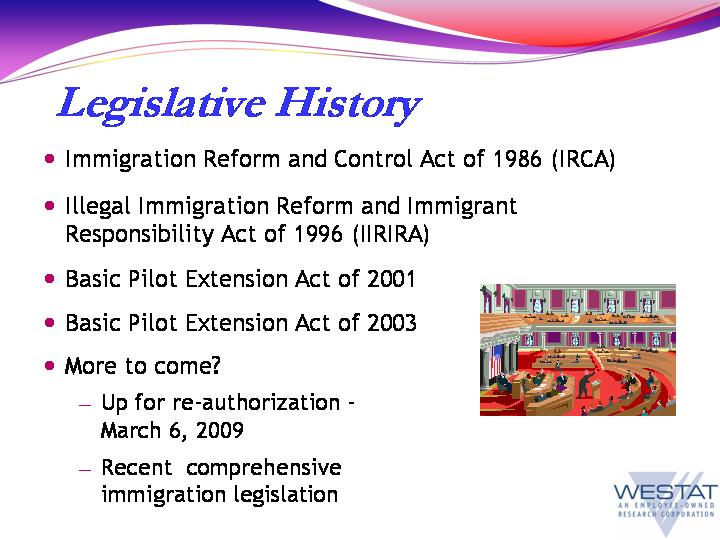
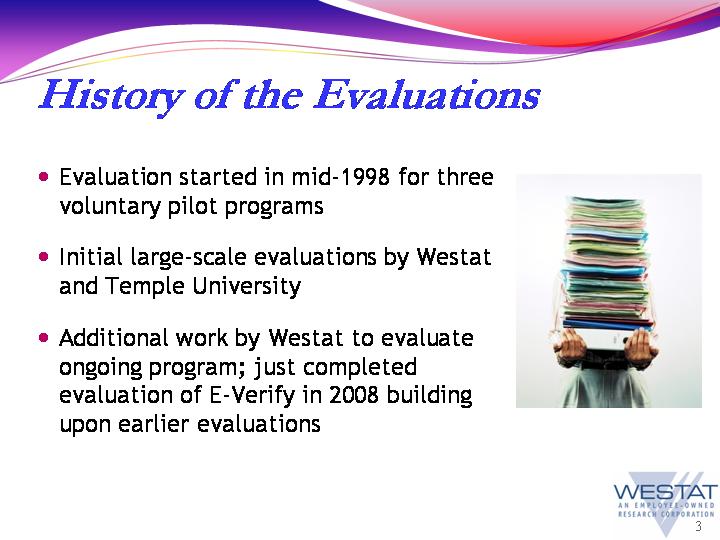
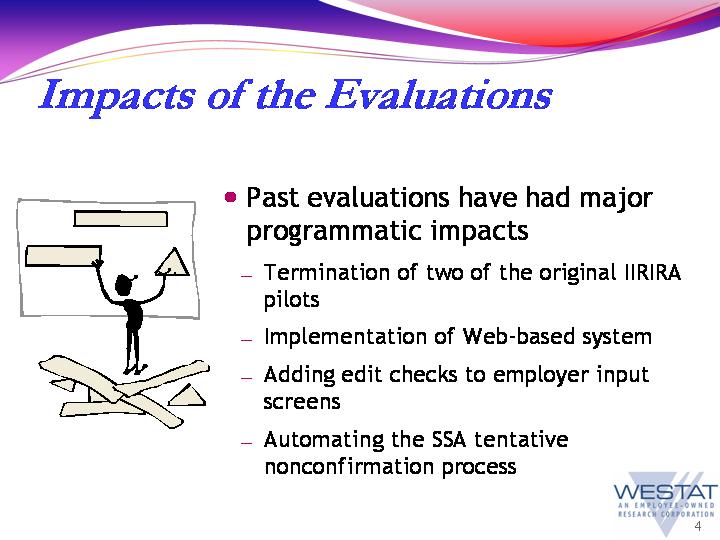


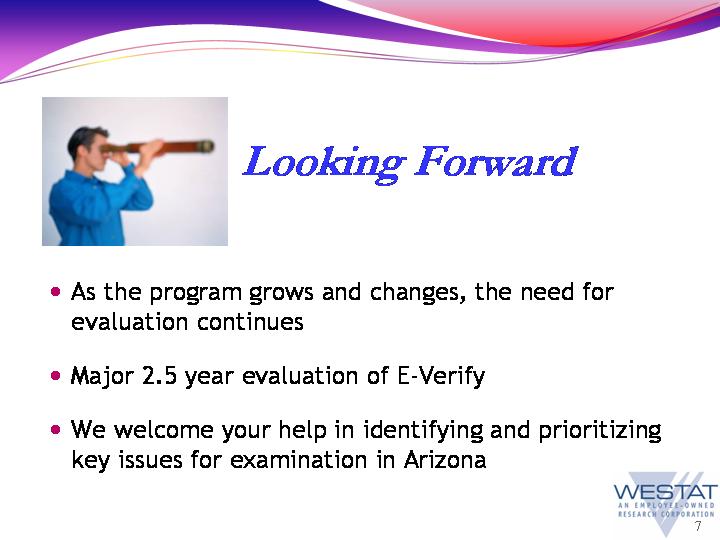
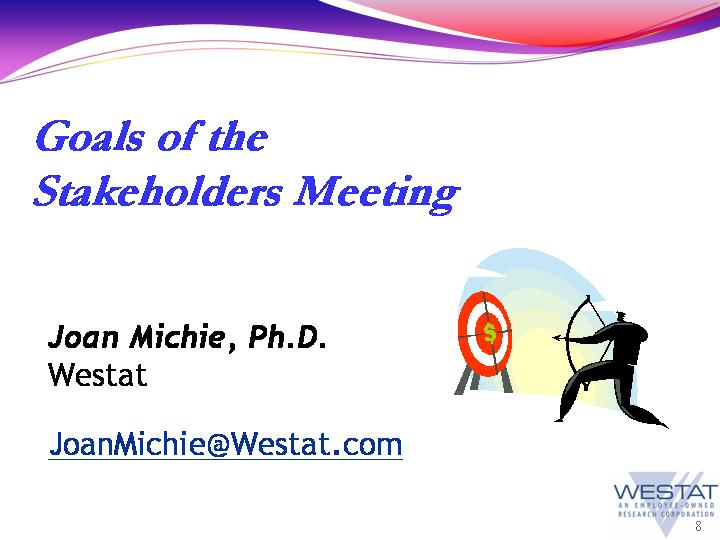
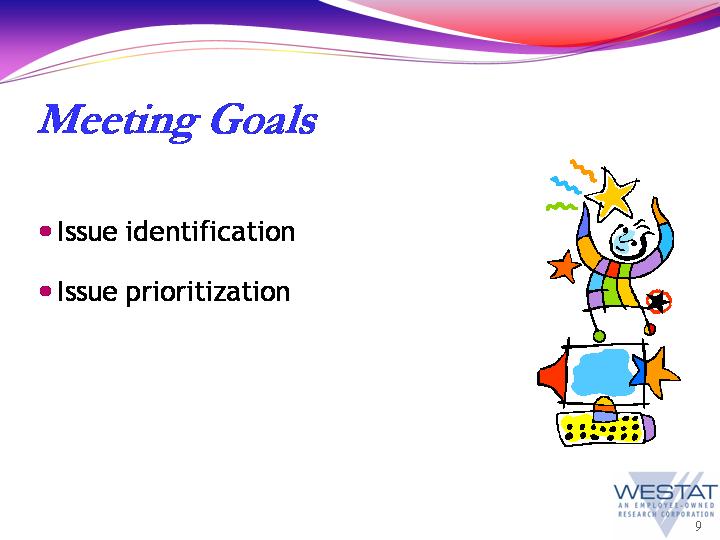
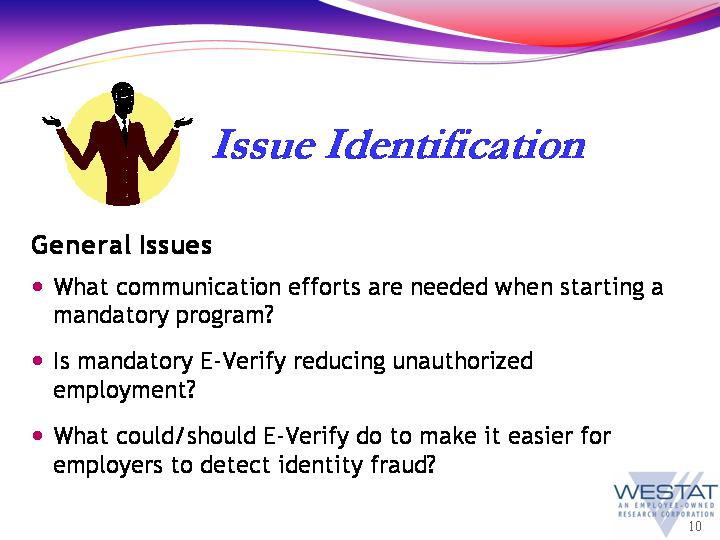
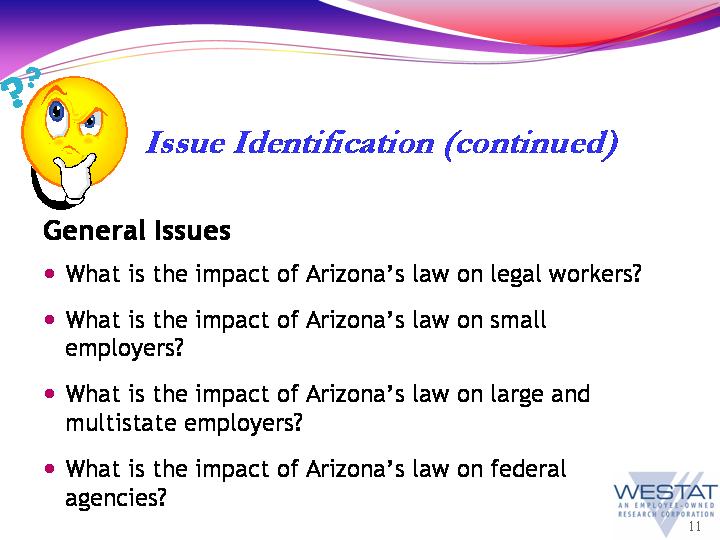
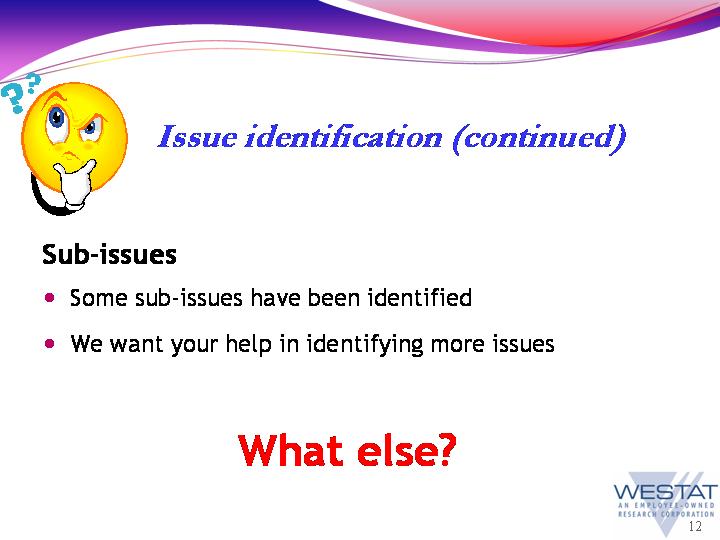
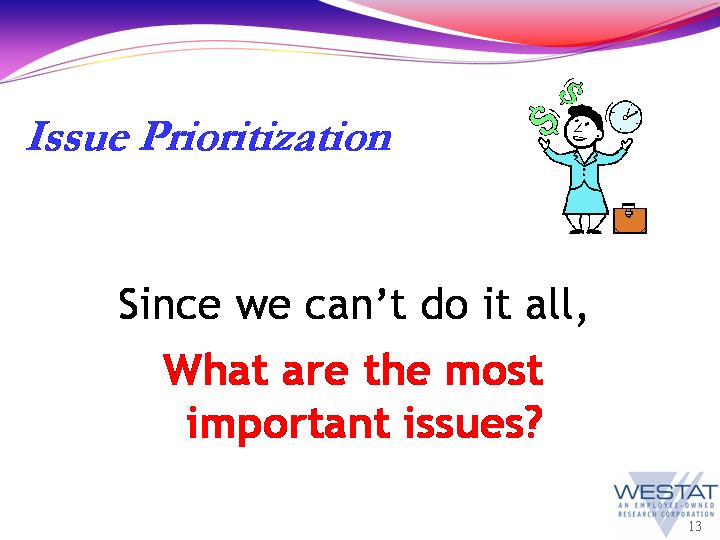
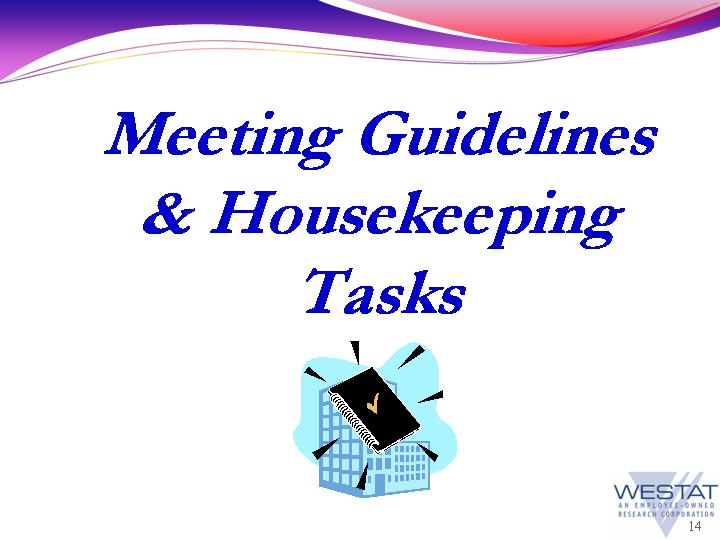
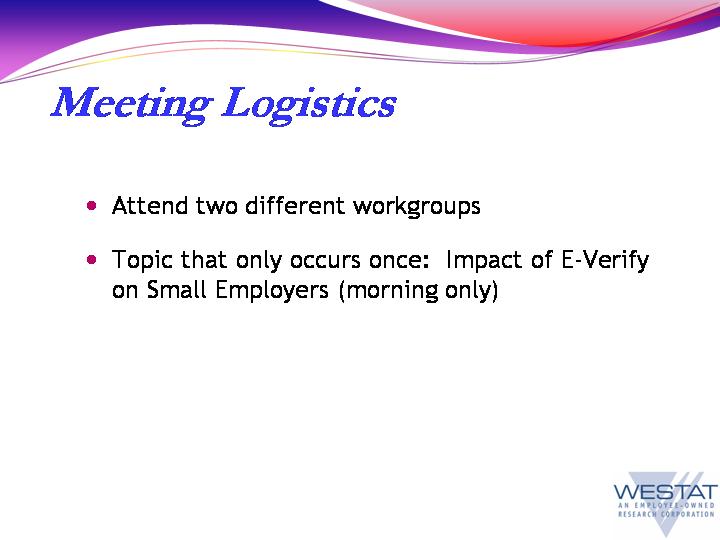

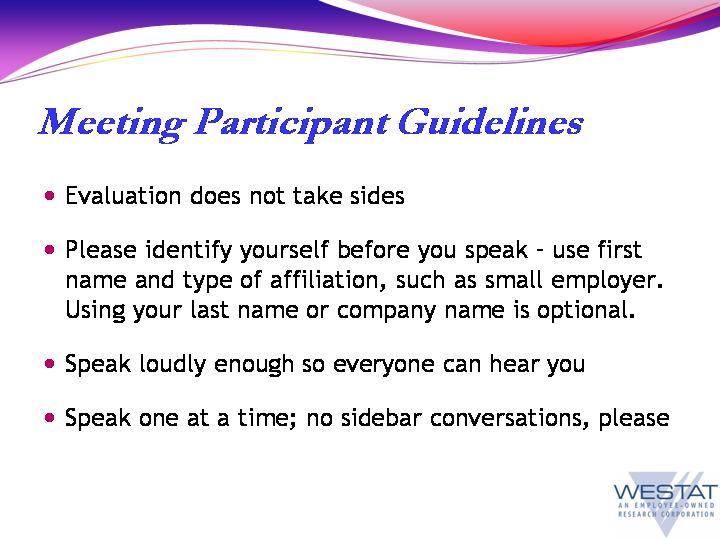
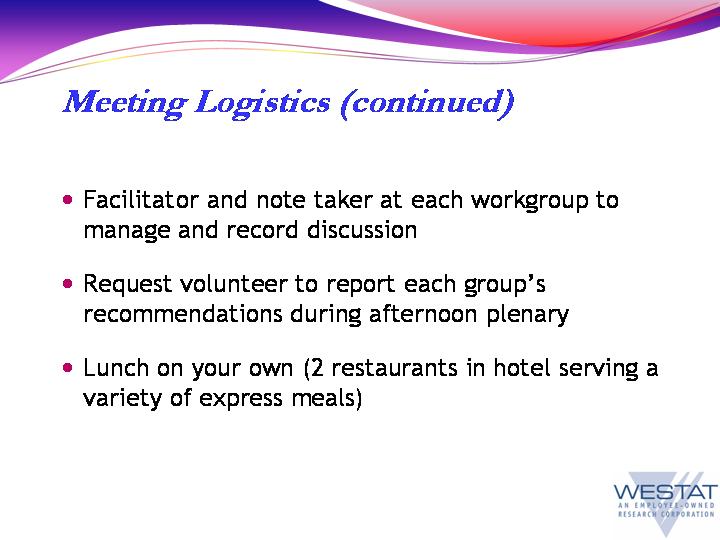


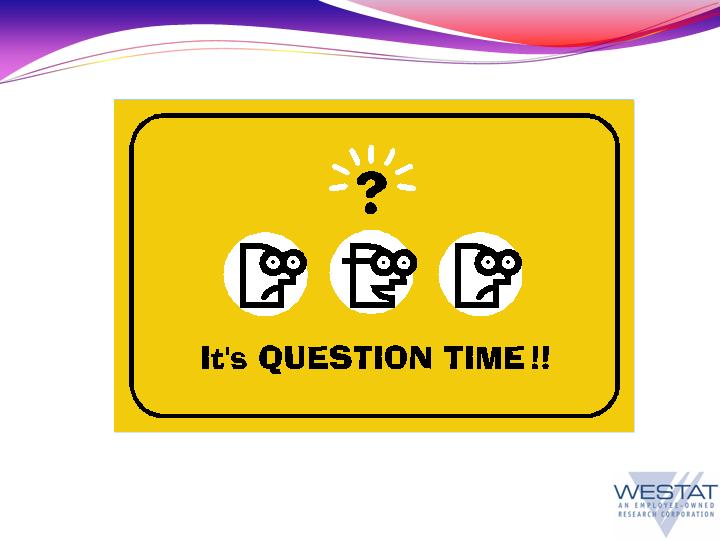
1 The Legal Arizona Workers Act, sometimes called the “Employer Sanctions Law,” went into effect on January 1, 2008. That law was amended in several respects by the Arizona Legislature, effective May 1, 2008. The Legal Arizona Workers Act, as amended, prohibits businesses from knowingly or intentionally hiring an “unauthorized alien” after December 31, 2007. Under the statute, an “unauthorized alien” is defined as “an alien who does not have the legal right or authorization under federal law to work in the United States.” The law also requires employers in Arizona to use the E-Verify system (a free Web-based service offered by the federal Department of Homeland Security) to verify the employment authorization of all new employees hired after December 31, 2007.
2 Available online at : http://www.uscis.gov/portal/site/uscis/menuitem.eb1d4c2a3e5b9ac89243c6a7543f6d1a/?vgnextoid=534bbd181e09d110VgnVCM1000004718190aRCRD&vgnextchannel=534bbd181e09d110VgnVCM1000004718190aRCRD .
3 For more information, see: http://www.acf.hhs.gov/programs/cse/newhire/employer/private/newhire.htm#whatis
4 See Arizona Attorney General’s Frequently Asked Questions online at: http://www.azag.gov/LegalAZWorkersAct/FAQ.html#hiredbefore
| File Type | application/msword |
| File Title | MARCH 9, 2009 STAKEHOLDERS |
| Author | Joan Michie |
| Last Modified By | Evadne Hagigal |
| File Modified | 2009-12-30 |
| File Created | 2009-12-30 |
© 2025 OMB.report | Privacy Policy